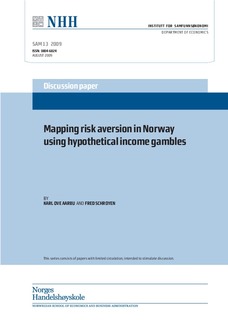Mapping risk aversion in Norway using hypothetical income gambles
Working paper
Permanent lenke
http://hdl.handle.net/11250/163174Utgivelsesdato
2009-08Metadata
Vis full innførselSamlinger
- Discussion papers (SAM) [658]
Sammendrag
This is the first study that explores the heterogeneity of risk preferences among the Norwegian population. We measure risk aversion as the complement of the maximal relative downside income risk a person is willing to bear with 50 percent chance in return for a doubling of their
income with 50 percent chance. The higher this fraction is, the more risk averse is the
respondent. Observing for each respondent the range to which their fraction belongs, we use an ordered probit model to estimate the effects of socioeconomic characteristics on risk aversion.
We find that women are more risk averse than men, that risk aversion increases with age, and people who are satisfied with their current life situation are significantly more risk averse than very satisfied and dissatisfied people. Under the assumption of constant relative risk-aversion
preferences, the sample average for the coefficient of relative risk aversion is 3.9 with a standard deviation of 2.9, reflecting strong heterogeneity of risk preferences. We also impute a cardinal risk measure to every respondent and use this as a regressor in various models that explain risky
behavior. We find that the likelihood to smoke, to work in the private sector, to assume the roleof a top manager, to work in a small firm, or to take up a loan to finance a risky investment
depends negatively on the imputed measure of risk aversion.
Utgiver
Norwegian School of Economics and Business Administration. Department of EconomicsSerie
Discussion paper2009:13
